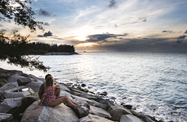Burgeoning cooperation between the national airline and the tourism board – and the latter’s development of a master plan – are raising the prospects of Brunei Darussalam’s tourism sector realising its untapped potential. However, challenges remain, as the industry tackles a human resources shortage and attempts to broaden the Sultanate’s appeal from that of niche destination.
In August, Royal Brunei Airlines (RBA) announced it would be adding extra flights to Taipei, Incheon and Narita following its appointment as the official airline of the prestigious Royal Trophy Europe versus Asia Golf Championship, which will be held in the Sultanate in December. The new destinations followed the launch of four major travel packages the previous week, in cooperation with the Brunei Tourism Board (BTB).
Named “Ulu-Ulu Fun”, “Family Fun”, “Nature to Wonder”, and “Free and Easy Leisure”, the airline has said the packages are designed to showcase the Sultanate’s bio-diversity, food, music, culture and pristine rainforests. The airline has said it expects the initiatives to be crucial in bringing tourists to the country.
Despite its political stability, strategic location in South-east Asia and a nascent medical tourism segment, the tourism industry has been seen as underperforming of late. In 2011, the Sultanate recorded 242,000 tourists, a 13% rise on the previous year, but it has targeted 400,000 annual visitors by 2016. According to a report by the board for the Asia-Pacific Economic Cooperation, direct tourism revenues in 2011 were some $154.35m, representing just 1% of GDP, while the industry employed 5200 people.
In May, Brunei Darussalam was ranked 67th out of 139 countries in the World Economic Forum’s Travel & Tourism Competitiveness Index – the same rank it received the previous year – placing it in a group with “clear strengths, counterbalanced by weaknesses”.
With hopes of increasing the sector’s contribution to the national economy, the tourism board has prepared a five-year master plan to be launched this year. A total of 69 projects have been identified that will stress the Sultanate’s natural assets and Islamic culture. Visitors from neighbouring Muslim-majority Malaysia dominated the market in 2011, with 61,500 arrivals. China placed a distant second at 33,900, Indonesia (20,000), Australia (18,845) and the UK (18,200).
Two growth clusters have been identified as part of the master plan. While the nature cluster will focus on eco-tourism, wildlife, adventure and education, the culture and Islamic cluster emphasises projects related to museums, handicrafts and Kampong Ayer, a “water village” in the capital that houses 30,000 people in houses on stilts and is connected by 36 km of boardwalks. Secondary offerings include diving, beach tourism and wellness products, as well as cruise tourism.
“The future vision of tourism in Brunei is based on the two pillars of nature. This is definitely the way forward, as it distinguishes Brunei’s model of tourism development as unique and special, and this is what tourism is all about,” Taleb Rifai, the secretary general at the UN World Tourism Organisation, told local media.
Rifai stressed that religious and secular tourism are compatible, as sacred sites and traditions appeal to both groups. “If [sites] are managed and visited on the basis of respect, these sites can boost tourism spending, which in turn can go towards their preservation,” he said.
A new business model that RBA is exploring will likely play a crucial role in the Sultanate’s tourism ambitions. In addition to the new routes and packages, recent initiatives included using London taxis to advertise during the 2012 Olympic Games and a re-launch of online check-in facilities.
While RBA expects five new Boeing B787 Dreamliners to be added to the fleet by 2014, Brunei International Airport is also undergoing a major upgrade, which will see a new passenger terminal and cargo terminal constructed by 2014, raising capacity from 1.5m to 3m per year.
However, to meet the tourism challenges the Sultanate will need to improve the state of tourism training, with human resources often cited as a key industry weakness. While the country has launched several tour guide courses and study programmes, critics say that to raise the image of travel and attract enthusiastic, career-minded and high-quality employees, a dedicated travel and tourism training facility should be established in collaboration with the private sector.

